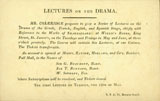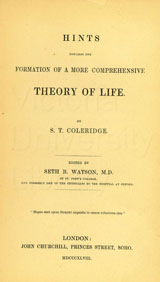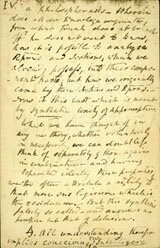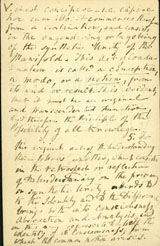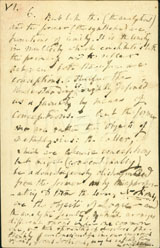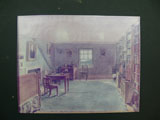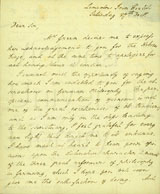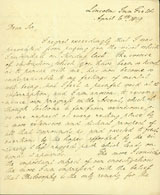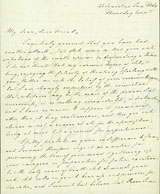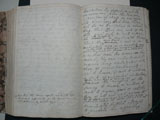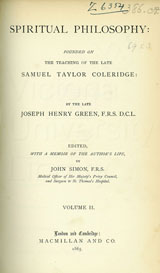In his maturity, Coleridge rejected both Enlightenment and (German) Idealist ways of accounting for the diversity of Creation and struggled to construct a more flexible, dynamic, and inclusive system of his own--in which, however, he aimed to incorporate the insights of earlier theorists. Sometimes he thought it was within his grasp, but he never succeeded in putting it all together. Evidence of his thinking can be found in some of the works published in his lifetime, such as the Introduction to the Encyclopedia Metropolitana but until the appearance of scholarly editions of his letters, notebooks, and collected works in the twentieth century, the system was known mainly from hints in scattered fragments and fugitive posthumous publications.
In 1817, shortly after moving to Highgate to lodge with James and Anne Gillman, Coleridge met another young surgeon, Joseph Henry Green (1791-1863), a Germanist, who became his philosophical disciple and collaborator. Green visited Coleridge almost weekly for study sessions from 1818 to 1834. He went on to achieve eminence in his field as Professor of Comparative Anatomy and then President of the Royal College of Surgeons, and the first Professor of Surgery at King's College, London; he also lectured on anatomy and aesthetics at the Royal Academy of Art.
A sampling of the little notebooks that Coleridge sometimes called "flycatchers"--for trapping stray thoughts--from the 1820s.
Coleridge notebooks 56, 59, 65
Coleridge recycled some of the pasteboard cards that had originally been produced to advertise his public lectures on drama in 1812. These notes, probably made ten years later, reflect his reading of Kant and have to do with the way the understanding brings multeity into unity.
Published from manuscript, the Theory of Life was written originally as part of Coleridge's contribution to an essay about scrofula that his friend and host James Gillman was planning to write. Coleridge found it necessary to go back to the first principles of biology in order to lay a foundation for the essay.
S. T. Coleridge. Hints towards the Formation of a More Comprehensive Theory of Life.
Edited by Seth B. Watson.
London: John Churchill, 1848.
An enlarged reproduction of pages from the MS "Opus Maximum", for which see Case 9, item 34.
An enlarged reproduction of pages from the MS "Opus Maximum", for which see Case 9, item 34.
An enlarged reproduction of pages from the MS "Opus Maximum", for which see Case 9, item 34.
An enlarged reproduction of pages from the MS "Opus Maximum", for which see Case 9, item 34.
Lithograph based on a watercolour of Coleridge's "Bed- and Book-room" at Highgate, made after Coleridge’s death by George Scharf, the elder. The portrait over the fireplace is thought to be of Green.
Coleridge’s Study.
Three unpublished letters from Green to Coleridge, from a group of fourteen in the Coleridge Collection. The letters shown range in date from December 1817 to March 1832, and in tone from "Dear Sir" to "My dear, dear Friend".
Joseph Henry Green.
Letters to Coleridge.
Three unpublished letters from Green to Coleridge, from a group of fourteen in the Coleridge Collection. The letters shown range in date from December 1817 to March 1832, and in tone from "Dear Sir" to "My dear, dear Friend".
Joseph Henry Green.
Letters to Coleridge.
Three unpublished letters from Green to Coleridge, from a group of fourteen in the Coleridge Collection. The letters shown range in date from December 1817 to March 1832, and in tone from "Dear Sir" to "My dear, dear Friend".
Joseph Henry Green.
Letters to Coleridge.
Coleridge dictated the three volumes known by this name between 1819 and 1823, as parts of an ambitious project described by Green as “a philosophical Cosmogony.” The enlarged shows a page with corrections in Coleridge's hand.
S. T. Coleridge "Opus Maximum" manuscript; hand of J. H. Green
As one of Coleridge’s executors, Green assisted with the publication of Literary Remains and set out to compile a matching set of Philosophical Remains (a fair copy of his Introduction is also in the Coleridge Collection). In his effort to articulate Coleridge's ideas in a systematic way, however, Green found himself departing from Coleridge's actual words, so his plan for a collection of previously unpublished manuscripts was replaced with the idea of an exposition of his own philosophical convictions, based on what he had learnt from Coleridge. He never finished it to his own satisfaction and it did not appear in print until 1865, two years after his own death and thirty years after Coleridge's.
Joseph Henry Green. Spiritual Philosophy: Founded on the Teaching of the Late Samuel Taylor Coleridge. 2 vols.
London: Macmillan, 1865.













